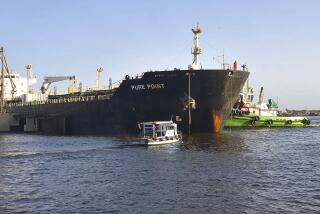‘Money for Missiles,’ Expert Charges : Despite Tensions, Iranian Oil Still Flows to America
- Share via
It is one of the many ironies of the relationship between the United States and Iran that 1.8 million barrels of Iranian crude oil sit at the ready in the U.S. Strategic Petroleum Reserve in Louisiana.
Congress created the reserve to protect the United States in case of a cutoff of oil from volatile places such as Iran. The managers of the reserve, under orders to make the best deal they can, bought a cargo of deeply discounted Iranian crude in 1982.
“It’s a market decision,” a Department of Energy spokesman said of the one-time transaction.
Unlike the French, who last week acted to ban their oil companies from importing Iranian crude oil, this country continues to permit the importing of oil from Iran. The only time it was banned was during the Iranian hostage crisis, though current oil imports from Iran are far below the levels of the 1970s.
Iranian oil currently accounts for roughly 1% of U.S. crude oil imports. But the purchase of a nominal 75,000 barrels a day in May, for example, meant about $1.35 million a day went to support Iran’s war machine, including the Chinese-built missiles that soon may be aimed at U.S. warships passing though the Strait of Hormuz and the mines Iran is said to be placing in the Persian Gulf and the Gulf of Oman.
“To this day, I find it preposterous that we are providing them the money for the missiles to shoot at American planes,” says G. Henry M. Schuler, an expert on energy security at the Georgetown Center for Strategic and International Studies in Washington.
Oil industry experts say that if Iran did not sell oil to the United States, it would sell to someone else. The world usually traffics in oil indiscriminately, with politics taking a back seat to price. Direct U.S. purchases of Iranian crude remain a minor factor for both countries.
“If we were not to buy Iranian oil, that doesn’t mean they’d sell that much less oil,” said John Lichtblau, president of the Petroleum Industry Research Foundation in New York. “It’s just a shift, like musical chairs. You get up and somebody else sits down.”
While the U.S. naval vessels are escorting tankers carrying oil from Kuwait, a supporter of Iraq, Iran’s foe in the almost seven-year-old gulf war, all of Iran’s oil also is carried by tanker through the Persian Gulf to such major customers as Japan and European nations.
Complete Reliance on Gulf
Iran’s complete reliance on the gulf for transporting the lifeblood of its economy is one reason some analysts say they believe the Iranians would be reluctant to trigger a full-blown military confrontation in those waters. The danger was underscored this week when a gulf mine damaged a tanker carrying Iranian oil destined for Europe.
While Iranian oil traffic to this country remains low, it has been climbing sharply in the last several months along with overall U.S. imports. After averaging 15,000 barrels a day in 1986, Iran has sent an average of 45,000 barrels a day over the first five months of this year, according to Department of Energy figures compiled by the American Petroleum Institute.
Beyond that, an unknown amount of Iranian oil ends up in American automobiles or furnaces, its identity lost when it passes through refineries in Rotterdam, the Virgin Islands, Singapore and other major refining centers serving Western oil companies.
Marketed Around World
Bijan Mossavar-Rahmani, an Iranian who is assistant director of the Harvard Energy and Environmental Center, estimates that one-fourth of all exported Iranian oil--which now totals nearly 2 million barrels a day--ends up in the supply systems of the major U.S. oil companies. Those firms market oil products around the world, so it is not known how much of the petroleum reaching American shores might have an Iranian tint.
Though the purchase of oil from Iran is legal, oil company executives say privately that they are inclined to steer away from it for public-relations reasons as long as plenty of other oil is available. That condition has prevailed since about 1982, and U.S. imports of Iranian oil have remained far below the levels of the 1970s when Shah Mohammed Reza Pahlavi’s oil fields were among this country’s leading suppliers.
Not only does Iran pose supply uncertainties because of its long war with Iraq, but there is usually no offsetting price or quality advantage to dealing with Iran, according to Lichtblau. Some U.S. oil companies are still arguing with Iran over what they are owed from the seizure of assets by the revolutionary government of the Ayatollah Ruhollah Khomeini in 1979.
Public Association Shunned
However, Mossavar-Rahmani says U.S. trading companies are large buyers of Iranian oil, often acting as middlemen for companies that are looking for oil cargoes but do not want to be publicly associated with an Iranian deal.
He cited Exxon as an example. But Exxon denies buying Iranian crude directly or through third parties in recent years.
Review of Trade Posture
The secret shipment of arms to Iran exposed in the Iran- contra scandal focused attention on U.S. exports to that nation, and State Department officials are reportedly reviewing the nation’s overall trade posture with Iran. Crude oil is one of several legal Iranian imports, along with such items as carpets, glassware, spices and pistachio nuts.
Iranian imports to the United States reportedly totaled $612 million last year, about one-fourth of it in oil. And with oil prices and import volumes rising this year, Iran’s crude shipments here stand to generate more and more cash for its economy.
On a per-barrel basis, however, Iran still is not realizing as much as it did from the 1982 sale of crude for storage in the underground salt domes at the Petroleum Reserve in Louisiana. In what was a bargain at the time, U.S. taxpayers paid Iran $29 a barrel, or about $52 million.
U.S. OIL IMPORTS Oil and oil products imported between January and May, 1987.
Barrels Country per day Canada 785,500 Venezuela 764,400 Mexico 658,600 Saudi Arabia 607,000 Nigeria 482,500 United Kingdom 373,600 Indonesia 305,600 Virgin Islands 268,000 Algeria 253,600 Angola 140,400 Iran 45,000
Source: American Petroleum Institute
More to Read
Sign up for Essential California
The most important California stories and recommendations in your inbox every morning.
You may occasionally receive promotional content from the Los Angeles Times.













